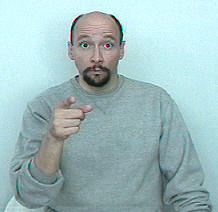In American Sign Language, facial expressions are an important part of communication.
Facial Expressions
The facial expressions you use while doing a sign will affect the meaning of that sign.
For example, if you sign the word "quiet," and add an exaggerated or intense facial expression, you are telling your audience to be "very quiet."
This principle also works when making "interesting" into "very interesting," or "funny" into "very funny."
Facial expressions are an example of a set of behaviors called "non-manual markers." Non-manual markers include facial expressions, head tilt, head nod, head shake, shoulder raising, mouth morphemes, and other non-signed signals that influence the meaning of your signs.
Also see: "Facial Expressions in Sign Language"
Also see: "Nonmanual Markers."
Consider how facial expressions can affect the simple sign "YOU."
This version of YOU is actually a question.
"Is it you?"
"Are you ... ?"
"Did you?"
Suppose you wanted to say, "It's you?!?! I wouldn't have thought that it would be you! I'm surprised by that."
You can say all that with just one sign by using appropriate facial expressions:
See an animation for this sign: "YOU" (surprised that it is you)
A student shares his secret to success with facial expressions::The secret to my success is that I'm Italian and I use my hands along with facial expressions. If I had to teach someone I would tell them to think about the meaning of the word not just the word itself. I would have them associate a certain facial and body expression with that word. Like the word "what" I would have them wave their hands flat in front of them like you do and use a facial expression such as squint their eyes and maybe bring their head a little bit forward. Also use of facial expressions as in a question type sentence so that them request a response from the other person. If you asked most people to give a facial expression for "sadness" or "happiness" I'm sure that they would know how to respond. Associating facial expressions for other words like "which", "what", "who", "how" is only a matter of coming up with expressions to associate with them. If your distance education students could just keep associating expressions with these types of words I'm sure they would have no problem with their expressive signs, but they have to practice.
Sincerely,
An Italian
05/17/05
In a message dated 8/30/2006 1:00:38 PM Pacific Daylight Time, twodogpurple@yahoo.com writes:Why do sign language people make funny faces?Dr. Bill's Response:
Becasue we like to laugh.
Bwahahahaha...
Ahem...er...no. While most of us do indeed enjoy a good chuckle, I believe what you are referring to is "facial grammar."
Facial movements and body language are a very important part of ASL.
Skilled users of ASL tend to use a lot of facial expressions to clarify and extend the meanings of their signs. How you use your face also helps establish if you are asking a question and whether that question is open-ended or if it should be answered with a simple yes or no response.
Cordially,
Dr. Bill
Also see: Facial Expressions: "If You Are Not Using Facial Expressions You Are Not Using ASL"
Dr. Bill's new iPhone "Fingerspelling Practice" app is now available! GET IT HERE!
NEW! Online "ASL Training Center!" (Premium Subscription Version of ASLU) ** CHECK IT OUT **
Also available: "ASLUniversity.com" (a mirror of Lifeprint.com less traffic, fast access) ** VISIT NOW **

